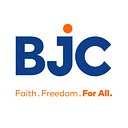Racial discrimination and public schools: the blurred lines of church-state separation
By Dr. Sabrina Dent
As the parent of an African American school-aged child and a religious freedom advocate, I celebrate how far America’s public education system has come since Brown v. the Board of Education of Topeka, Kansas (1954). The landmark U.S. Supreme Court case determined that racial segregation in public schools is illegal and unconstitutional. Whereas, church-state separation as written in the First Amendment is clear cut for many white religious and nonreligious people, the connection for many Black people, communities of color, and religious minorities is filled with contradictions and complexities.
For centuries, the State and the Church have never ceased to separate themselves when it came to the existence of people of the African Diaspora. They both contributed to the dehumanization and marginalization of Black people. April 4, 1865, is an important date in my family. The Dents of Roduco, N.C. It was the day my great- great- great grandfather Napoleon Dent was emancipated from slavery. Many years later, it would be my great grandfather who established a church in his hometown that would also serve as a community hub for children and families providing social support and education. We, Black people, have always had to create our own. If it was given to us, we had to use our ingenuity and brilliance to make it the best.
An example of such happened in Norfolk, Virginia, in 1958 when U.S. Senator Harry S. Byrd called for a halt to the integration of public schools. This was in response to the acceptance of the seventeen Black students — known as the “Norfolk 17” — that would be the first to integrate Norview High School. In a letter to Gov. Almond, the Norfolk Committee for Public Schools wrote:
“We believe that Massive Resistance was never intended to punish the white school children of the state. It was never intended to punish the entire populace economically. Because of federal court decisions, however, it is powerless to do otherwise than punish those who least deserve it …”
As a result, to defy desegregation efforts, Gov. Almond ordered the closing of schools in Charlottesville, Norfolk, and Front Royal, which displaced not only the Black students but thousands of white students. In the documentary “Norfolk, Virginia’s Massive Resistance to Integration,” Andrew Heidelberg and Dr. Patricia Turner recount their experiences of that year. Their stories are significant to understanding the complexities of church-state separation for Black people in the United States. Yet, the words written by the Norfolk Committee for Public Schools suggest that only white children were the victims of these circumstances who deserved better treatment.
During the 147-day school shutdown, it was First Baptist Church of Bute Street in Norfolk, Virginia — my paternal grandmother’s church — that would open its doors for the Norfolk 17 to continue their education. This historic Black Baptist congregation founded in July 1800 prioritized the needs of these students in the face of racial and legalized discrimination.
For the Black community, access to education has continuously been a critical factor in contributing to one’s ability to succeed in life. Many stories of resistance were birthed through Black churches — similar to First African Baptist Church in my hometown of Petersburg, Virginia — that created education programs to provide Black youth a quality education when society and public school officials said they were not enough nor worthy.
And yet, I am a proponent of church-state separation when it comes to public schools. Public schools are places that serve children from every racial, ethnic, socio-economic, sexual and gender identity, and religious background. Voucher programs — which were established to defy desegregation orders in the 1950s, 60s, and 70s (and today) — minimize that diversity due to admission requirements that sometimes isolate religious minorities, poor people, students with disabilities, or those that identify as members of the LGBTQ community.
In the state of Virginia, there are over 1 million students enrolled in public schools. This includes rural, urban, and suburban areas that point to additional diverse experiences and different budgetary concerns (i.e. education materials, access to broadband, transportation needs, healthy school lunch programs, counseling services, etc.). Taking taxpayer money from public education to fund charter or private religious schools creates division and suggests that some children are more important than others. It’s unethical, immoral, and a violation of our constitutional principles. As we learned from the experiences of the Norfolk 17, it is critical that all children (especially in Virginia) learn the histories of Indigenous peoples, enslaved and free Blacks, Japanese and Mexican Americans, the Holocaust, and many other events that have shaped or influenced public policies, laws, American culture, and public education. EVERY BIT OF HISTORY MATTERS!
My relationship with church-state separation is more than transactional or superficial: It seeks to affirm the human dignity and rights of every child to have access to a quality education in public schools without the threat of discrimination or religious privilege. Teaching history as it happened is not about making a child or group feel bad but provides a way for students to learn lessons of the past to prevent similar tragedies from occurring in the future. This ultimately helps prepare our students to be better thinkers, citizens, and contributors to society — what better place to happen than in public schools.
Sabrina E. Dent, DMin. is president of The Center for Faith, Justice, and Reconciliation; editor and author of the book African Americans and Religious Freedom: New Perspectives for Congregations and Communities; and a Center for American Progress Faith Leader to Watch in 2021.
